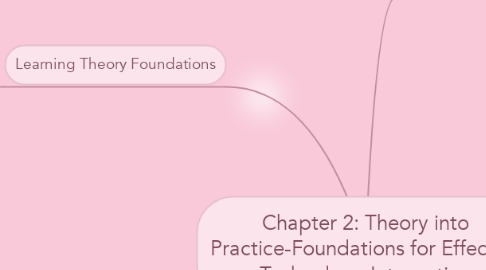Chapter 2: Theory into Practice-Foundations for Effective Technology Integration
by Sarah Cramer


1. Directed Models
1.1. Integration to remedy identified weaknesses or skill deficits
1.2. Integration to promote skill fluency or automaticity
1.3. Integration to support efficient, self-paced instruction
1.4. Integration to support self-paces review of concepts
2. Essential Conditions for Integration
2.1. Standards and curriculum support
2.2. Technical assistance
2.3. Shared vision for technology integration
2.4. Access to resources
2.5. Skilled personnel
2.6. Engaged community
2.7. Appropriate Teaching and Assessment Approaches
2.8. Required Policies
3. Learning Theory Foundations
3.1. Directed Instruction
3.1.1. Objectivism
3.1.1.1. Teacher directed
3.1.1.1.1. Transmitted to people and stored in their minds
3.2. Inquiry Based Instruction
3.2.1. Constructivism
3.2.1.1. Student centered
3.2.1.1.1. Created by background, experiences, and aptitudes
4. Technology Integration Strategies
5. Both
5.1. Integration to generate motivation to learn
5.2. Integration to optimize scarce personnel and material resources
5.3. Integration to remove logistical hurdles to learning
5.4. Integration to develop information literacy and visual literacy skills
6. Constructivist Models
6.1. Integration to faster creative problem solving and tetacognition
6.2. Integration to help build mental models and increase knowledge transfer
6.3. Integration to faster group cooperation
6.4. Integration to allow for multiple and ditributed intelligences
7. Technology Integration Planning Model (TIP)
7.1. Phase 1: Analyssi of learning and teaching needs
7.1.1. Step 1: Determine relative advantage
7.1.2. Step 2: Assess Tech-PACK
7.2. Phase 2: Planning for integration
7.2.1. Step 3: Decide on objectives, assessments
7.2.2. Step 4: Design integration strategies
7.2.3. Step 5: Prepare instructional environment
7.3. Phase 3: Post-Instruction Analysis and Revisions
7.3.1. Step 6: Analyze results
7.3.2. Step 7: Make revisions
